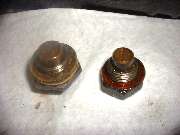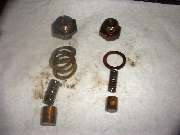The MGA With An Attitude
DIAGNOSING FRONT END SHIMMY - SR-103
At 10:36 AM 7/23/03 -0500, Tyler Irwin wrote:
>"Who instructed the MGA steering rack tech session?"
Guilty. (Hand in air here).
>"My steering is awfully touchy and sensitive at highway speed. Wants to instantly drift left and right all the time."
If that was caused by the steering mechanism, your steering wheel would likely have at least 1/2 inch of free pay at the rim. This is rather unusual to be a problem in the rack itself, but if so it would be loose inner tie rod ends inside of the large rubber bellows seals.
>"It acts like I'm running a bias ply tire when I'm not."
Most likely something is loose or worn in the front suspension.
>".... Toe-in is good. No play in steering wheel, u-joint, or upper/lower shaft."
To check for looseness in the front suspension you have to unload the working forces on the parts caused by the weight of the car and the compression of the coil spring. Place a floor jack under the lower suspension arm, directly under the coil spring, and lift the wheel off the floor. This takes the weight of the car and the full force of the spring on the jack, and the only suspension joint with any remaining load is the inner a-arm pivot. All other suspension joints outboard and upward from the jacking point will then be free with no load, such that you could totally disassemble the suspension (except for the lower arm inner pivot).
Grasp the tire at 9 o'clock and 3 o'clock position and move it gently a couple of degrees through steering motion. Check the steering tie rod for any free play in the outer ball joints. There should be no play there, and if there is the part needs to be replaced. Also watch the tie rod to see if it might move any in/out without motion of the steering wheel. There should again be no freeplay here. If there is any freeplay, this indicates wear in the inner ball joint inside of the bellows. That joint is adjustable (with a certain amount of grunt and finesse), such that you can reduce the internal clearance by removing shims.
Also check for any motion between the brake drum and backing plate (1500 cars), or between the brake rotor and caliper (1600 cars). There should be little to no motion detectable here. Motion here indicates worn wheel bearings, which would need to be replaced, or loose or missing parts in the spindle bearing assembly. The MGA uses ball bearings in the front hubs. There should be an inner race spacer in between the bearings on the spindle, and the large spindle nut should be very tight. If the spacer is missing, tightening the nut will make the bearings bind.
With proper care, periodic cleaning and repacking and new seals, the front wheel bearings should last a long time. I replaced mine at about 250,000 miles, but mostly on general principals, as they were not significantly worn at that time. Front wheel bearing failure is usually caused by either lack of lubrication or contamination from failed hub seals.
Grasp the tire at 12 o'clock and 6 o'clock position and shake it with some vigor. Watch for any freeplay motion at the upper and lower swivel links (at top and bottom ends of the swivel pins). The swivel links on the MGA are threaded onto the swivel pins. This functions similar to a king pin, but having a threaded connection rather than bushings. If there is any detectable play in the joint between the swivel pin and the swivel link, that indicates wear in the female thread, and the cast iron swivel link needs to be replaced. The steel swivel pin is harder material and usually doesn't wear much, but it could be corroded if the seals fail and it lacks grease. The bottom joint is more likely to be worn than the top one.
Also watch for any freeplay motion at the upper and lower trunnion joints (large horizontal bolts). There should be no detectable motion. Any freeplay here indicates wear in the bronze bushings, which would need to be replaced. The lower trunnion carries the weight of the car in motion. The upper trunnion holds the wheel up straight and takes the resistive forces of the shock absorber. Both of these joints can wear, but the lower joint is likely to have more wear and more likely to be loose. If these joints were not greased for a long time the bronze bushing may sieze on the steel sleeve, and the large bolt may rotate and move around. The result of that motion is a badly necked down bolt and oval holes in the a-arm side brackets, and those parts would need to be replaced.
For the general procedure for disassembly and reassembly of the front suspension, and pictures of some of the problems you may encounter, check here:
www.chicagolandmgclub.com/photos/mgb_susp
MGB and MGA front suspension is very similar, except the MGA has swivel pins in place of the king pins, and the MGA has bushings in both top and bottom trunnions, and uses ball bearings in place of the tapered roller bearings of the MGB.
For notes and a picture tour of installation and reaming of the trunnion bushings, see article FS-201
>"Both damper nuts tight with new brass dampers, torqued down all the way. No shims in the big one, but free movement of rack is there."
Ouch. This is definitely wrong. The brass damper pin should be longer than the space allowed, such that if this is assembled with no shims the part should bind up severely on the rack before the large cap nut bottoms out against the shoulder on the outside. It should not be possible to tighten the nut all the way down with no shims.
For assembly and adjustment of the main rack damper, see
SR-201
see the pictures, 4th row up from the bottom of the page, and the two paragraphs to follow. Also these two earlier pictures for the parts which should be in the damper assemblies:


>"Are my inner tie rods or shims worn out?"
Can't tell until you check, but probably not. Mine went well over 200,000 miles before showing any significant wear at the inner ball joints, and it was over 300,000 miles before it was loose enough to bother me when I fixed it. They can wear much faster if the end boots are broken, the oil escapes, and dirt may get into the assembly. So it pays to replace the large gaiters immediately when you notice the may be cracked and leaking.
Your description sounds like you may have incorrect or missing parts for the main rack damper. That alone is not likely to cause twitchy steering as bad as you describe, so I suspect you also have some worn parts in the suspension, most likely worn lower trunion bushings, or possibly loose wheel bearings. Excessive toe in for the front tire alignment can also make the car oversteer and dart back and forth across the road.
Regards,
Barney Gaylord
1958 MGA with an attitude
www.MGAguru.com
also Editor and Webmaster
Chicagoland MG Club
www.chicagolandmgclub.com
|